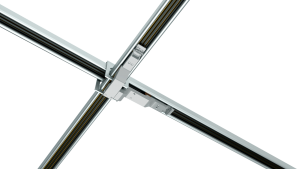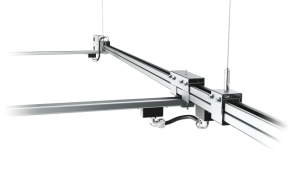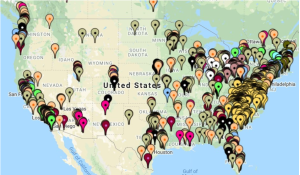The specific installation procedures can vary depending on the type of busway. The following is a general overview of the busway installation process:
- Mounting Supports: Install supports or hangers that will hold the busway.
busSTRUT manufactures aircraft cables for attachment to structure. Our cables comes with pre-installed ¼-20 eye bolt for use with various types of fasteners.
- Assembling Sections: Connect the busway sections together. This involves securing the suspended sections together with pre-fabricated joiners and X, T, or L intercepts (also known as “elbows” and “tees”).
Elbows and tees are typically difficult to install, and an X connector is almost impossible. However, busSTRUT track busway intersections require no in-field wiring. A busSTRUT slimline jumper clips onto a mechanical crossover intercept as needed. The image below shows this busSTRUT mechanical and electrical intersection that does not require any in-field wiring.

- Installing end caps: Busways typically have exposed copper at the ends of each length. The exposed copper typically supplies power to abutting lengths using joiners. Where there are no joiners installed, typically end caps are installed for safety on the open ends of each row or column of the busway.
Another unique feature of busSTRUT track busway is that each length we manufacture comes with end-caps pre-installed. busSTRUT engineered an electrical joiner connector that bypasses the end caps – maximizing safety and eliminating the need for end-caps to be separately sold.
- Electrical Connections: Busway’s higher ampacity reduces the amount of feeds required. Those few hard-wired electrical connections to the panel are critical.
Busway branch circuits are typically greater than a traditional 20amp circuit. With higher ampacity, comes larger pipe-and-wire and panels that may be costly.
Unique to busSTRUT busway is our lower ampacity. We manufacture 20amp and 40amp sections that work seamlessly together. busSTRUT/40 trunking distributes power to the busSTRUT/20 branches for plug-ins. With busSTRUT 20amp track busway, you avoid the need for the costly fuses traditionally required on busway plug-ins. The National Electrical Code requires all plug-ins mated with busways exceeding 20amps to be fused.
Double-decked busSTRUT/40 powers the busSTRUT/20 branches in the image below.

- Attachments: For plug-in style busways, you can add plug-in units or tap-off boxes anywhere along the busway.
busSTRUT track busway is a plug-in style busway with Plug & Play fittings.




